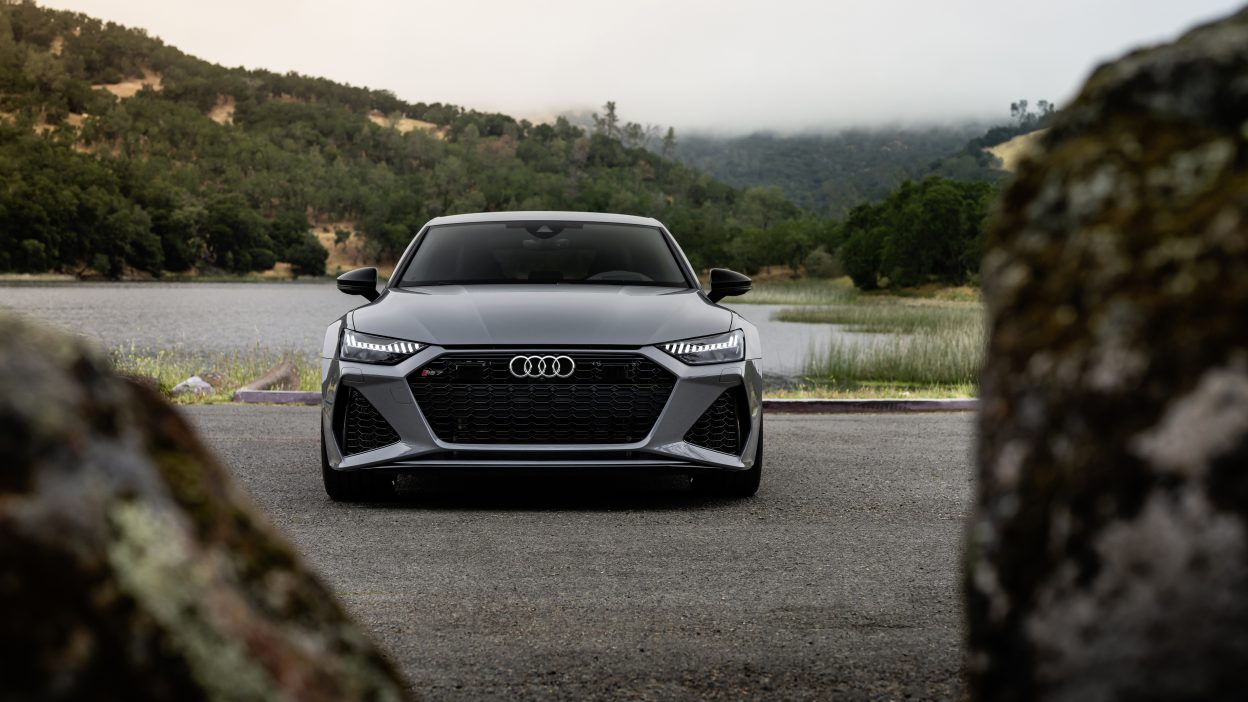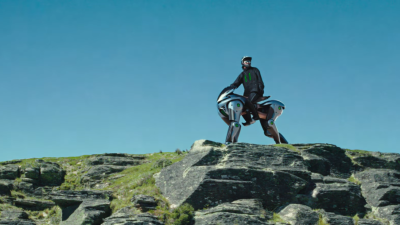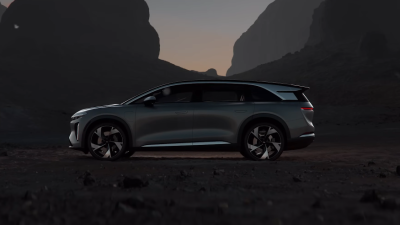Introduction
There’s something undeniably magnetic about a car that can shuttle you to a black-tie event in whisper-quiet luxury, then transform into a snarling track monster with just a push of a button. The Audi RS7 embodies this automotive duality better than perhaps any other vehicle on the market today. As we stand on the precipice of the electric revolution, this grand tourer represents what might be the last golden age of internal combustion engineering – a 621-horsepower love letter to petrol-heads wrapped in a sophisticated four-door package.
In this deep dive, we’ll explore everything that makes the RS7 special – from its engineering brilliance to its cultural significance. Whether you’re a dedicated Audi enthusiast, a performance car aficionado, or simply someone who appreciates automotive excellence, there’s something here that will capture your imagination. Let’s pop the hood on what might be the ultimate “stealth wealth” performance car.
The Evolution of a Legend: RS7 Through the Generations
First Generation (2013-2018): The Blueprint for Modern Performance
When Audi unveiled the first RS7 at the 2013 Detroit Auto Show, it wasn’t just introducing another fast sedan – it was redefining what a grand touring car could be. Based on the elegant A7 fastback, the Audi RS7 combined supercar performance with everyday usability in a package that many competitors have since tried (and largely failed) to replicate.
The original Audi RS7 shocked the automotive world with its 560-horsepower 4.0L TFSI V8 engine, a mechanical masterpiece that could launch this luxury sedan from 0-60 mph faster than many dedicated sports cars of its era. But Audi wasn’t content to rest on its laurels.
The evolution of the first-generation Audi RS7 followed a clear pattern of continual improvement:
- 2015 Update: Engineers revised the throttle mapping for more responsive acceleration and introduced a sport exhaust option that added a 15-horsepower overboost function – because who doesn’t want more power?
- 2016 Performance Pack: This is where things got serious. Audi boosted output to 605 horsepower, added massive carbon-ceramic brakes with 420mm front rotors (larger than some car’s wheels!), and implemented a torque-vectoring rear differential that transformed the car’s handling characteristics.
What made the first-generation Audi RS7 special wasn’t just its raw numbers – though those were impressive – but its character. It established what automobile enthusiasts now call the “stealth wealth” performance car: understated luxury with supercar-slaying capabilities. While it didn’t broadcast its performance credentials with outlandish wings or scoops, those in the know recognized it as something special. Interestingly, independent tests showed it could outpace the much flashier Porsche Panamera Turbo in straight-line acceleration.
Second Generation (2020-Present): Engineering Excellence Refined
If the first Audi RS7 was impressive, the current model elevates the formula to new heights with cutting-edge technology wrapped in an even more striking package. The second-generation RS7 debuted with a 591-horsepower mild-hybrid V8 system, combining traditional internal combustion with a 48-volt belt-alternator-starter system.
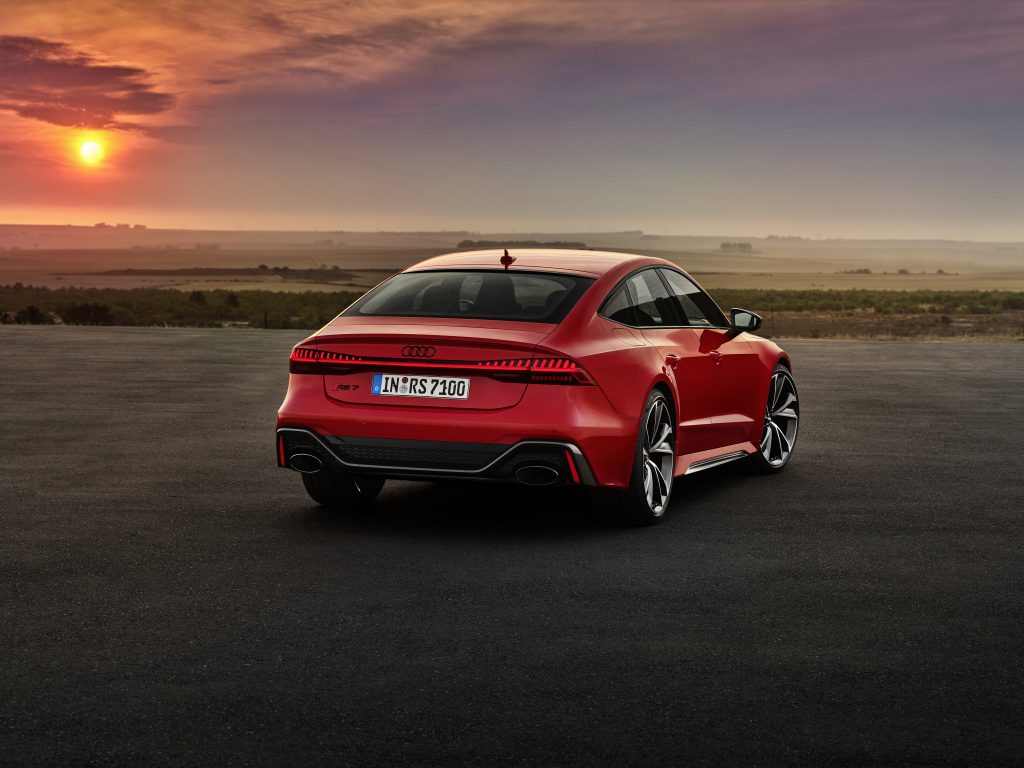
The 2024-25 models received further enhancements, pushing power output to 621 horsepower thanks to revised turbochargers and sophisticated ECU tuning. But raw power is only part of the story – the chassis received equally impressive upgrades:
- Four-wheel steering: The rear wheels can turn up to 2.8 degrees, providing nimble handling at low speeds and rock-solid stability when pushing the limits.
- RS adaptive air suspension: Three-stage damping allows the car to transform from comfortable cruiser to track-ready performer at the push of a button.
- Active aerodynamics: The rear spoiler generates 220 pounds of downforce at 155 mph, keeping this 4,985-pound luxury missile planted firmly on the ground.
The second generation represents Audi’s holistic approach to performance, addressing not just straightline speed but handling, braking, and everyday comfort in equal measure.
Under the Skin: Technical Deep Dive
Powertrain Engineering: A Symphony of Forced Induction
The heart of any performance car is its engine, and the RS7’s 4.0-liter TFSI V8 is nothing short of engineering brilliance. What makes this power plant special isn’t just its raw output but how it delivers that power.

The twin-scroll turbochargers are nestled in what engineers call a “hot V” configuration – positioned within the valley between the cylinder banks rather than hanging off the sides. This arrangement significantly reduces turbo lag to just 1.2 seconds, delivering near-instantaneous response when you press the accelerator.
The fuel delivery system utilizes dual direct and port injection with a 200-bar rail pressure, ensuring optimal atomization under all conditions. Dual intercoolers keep intake temperatures in check, even under the most demanding driving scenarios.
Perhaps most impressive is the mild-hybrid system, which provides a 12kW boost during acceleration while enabling seamless start-stop functionality. This system not only improves performance but also helps reduce fuel consumption during everyday driving – a perfect example of having your cake and eating it too.
Performance That Defies Physics
The performance figures of the Audi RS7 tell a compelling story:
- 0-60 mph: Audi claims 3.3 seconds, though independent testing by Car and Driver measured it at an even more impressive 3.0 seconds
- Quarter-mile: 10.9 seconds at 129 mph
- Braking: 152 feet from 70-0 mph with the optional carbon-ceramic brakes
- Top speed: 190 mph (with the Dynamic Plus Package)
These numbers become even more impressive when you consider the RS7’s size and weight. At nearly 5,000 pounds, this is no lightweight sports car, yet it accelerates, turns, and stops like vehicles weighing significantly less. The magic lies in how Audi’s engineers have managed the physics.
Chassis Dynamics: The Secret Sauce
The RS7’s handling prowess comes from a sophisticated chassis that features:
- Electronically controlled rear differential: Capable of directing up to 1,750 Nm of torque to the wheel with the most grip
- Five-link front/multi-link rear suspension: With elastokinematic tuning that balances comfort and performance
- Weight distribution: A respectable 55:45 front-rear split that helps mitigate the inherent understeer tendency of nose-heavy AWD vehicles
What’s particularly noteworthy is how the Audi RS7 manages its considerable mass. Through clever suspension tuning and advanced electronic aids, it disguises its weight in a way that makes it feel much lighter and more nimble than the specifications would suggest.
Luxury Meets Performance: Interior and Technology
Cabin Design: Where Form Meets Function
Step inside the RS7, and you’re greeted by a cabin that perfectly balances luxury and sportiness. Every surface, control, and detail has been meticulously designed to enhance both comfort and performance.
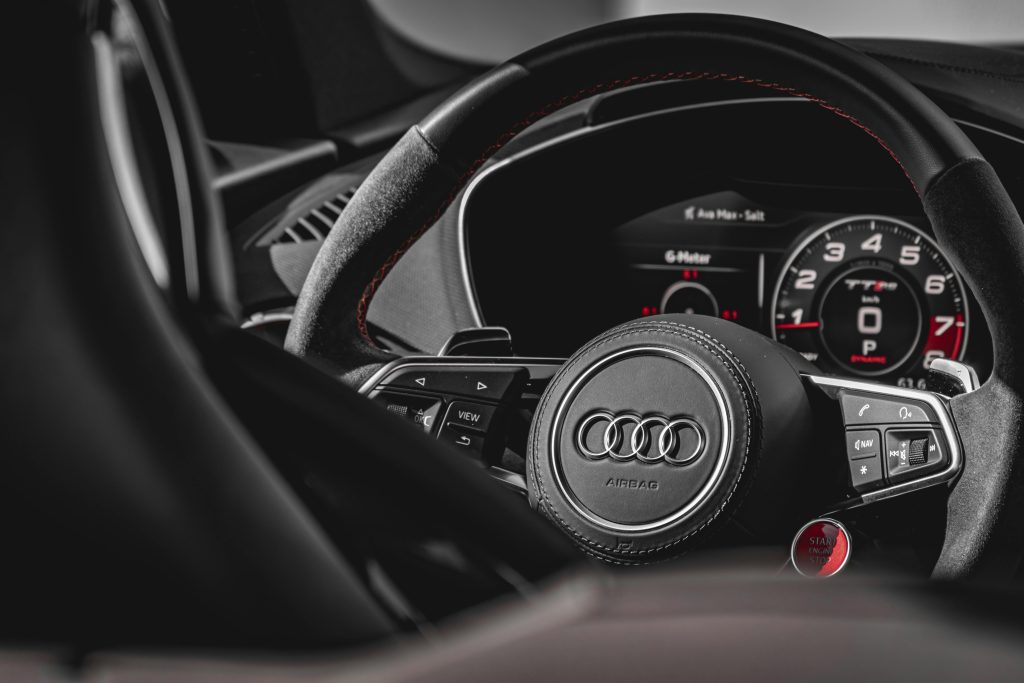
The materials are nothing short of premium:
- Valcona leather with diamond stitching: Providing both visual appeal and exceptional comfort
- Optional Alcantara headliner: Adding a touch of motorsport-inspired luxury
- RS-specific bucket seats: With 18-way adjustment and massage function that keep you comfortable on long journeys and securely in place during spirited driving
What truly sets the Audi RS7 apart from lesser vehicles is how it blends this luxury with genuine practicality. The fastback design provides a surprising 24.9 cubic feet of cargo capacity, expandable to 49.1 cubic feet with the rear seats folded – more than many SUVs offer. This combination of performance, luxury, and utility is the RS7’s unique selling proposition.
Cutting-Edge Technology: Digital Excellence
The RS7’s technology suite is as impressive as its performance credentials:
- MMI Touch Response: Dual haptic screens (10.1″ upper, 8.6″ lower) with LTE Advanced connectivity
- Virtual Cockpit Plus: Featuring RS-specific modes including a G-meter and lap timer for those track day adventures
- Sonos 3D Audio: A 16-channel, 705-watt system with Dirac Unison tuning that delivers concert-hall sound quality
These systems aren’t just for show – they enhance the driving experience in meaningful ways. The Virtual Cockpit, for instance, can be configured to display performance metrics like power output, torque, g-forces, and even lap times, allowing drivers to monitor their performance in real-time.
Market Position: How Does It Stack Up?
Competitive Analysis: The Performance Luxury Segment
The high-performance luxury sedan market is fiercely competitive, with each manufacturer bringing something unique to the table. Here’s how the Audi RS7 compares to its primary rivals:
| Model | Power | 0-60mph | Price | Key Differentiator |
|---|---|---|---|---|
| Audi RS7 | 621hp | 3.3s | $126,000 | Hatchback practicality |
| BMW M5 CS | 627hp | 2.9s | $143,000 | Track-focused dynamics |
| Porsche Panamera Turbo S | 621hp | 3.0s | $199,000 | PDK transmission |
| Mercedes-AMG GT63 S | 630hp | 3.1s | $163,000 | Active roll stabilization |
What becomes immediately apparent is the RS7’s value proposition. While its performance metrics are comparable to competitors costing tens of thousands more, it offers the practical advantage of a hatchback design that its rivals lack. This combination of performance, luxury, and utility at a (relatively) attainable price point makes the RS7 a compelling option for discerning enthusiasts.
Ownership Experience: Beyond the Purchase
Owning an Audi RS7 involves considerations beyond the initial purchase:
- Maintenance: Expect to spend approximately $1,200 per year with 10,000-mile service intervals
- Reliability: Common issues include coolant leaks around the thermostat housing and occasional mild-hybrid battery failures
- Tuning Potential:
- Stage 1 (ECU): 680hp/650lb-ft for about $1,500
- Stage 3 (Hybrid Turbos): 800+ horsepower for investments starting around $15,000
What’s particularly impressive is the RS7’s reported 92% satisfaction rate in J.D. Power surveys – a testament to how well it delivers on its promises to owners.
Cultural Impact: More Than Just Transportation
Pop Culture Presence
The RS7 has transcended its role as mere transportation to become a cultural icon. It famously appeared in “Avengers: Age of Ultron” as Tony Stark’s personal vehicle – a fitting choice for a character known for his appreciation of cutting-edge technology and performance.
Its motorsport pedigree is equally impressive. In 2016, the Audi RS7 Performance completed the Nürburgring in 7:52, setting a record for production luxury cars at the time. This combination of on-screen presence and real-world performance has cemented its status in automotive culture.
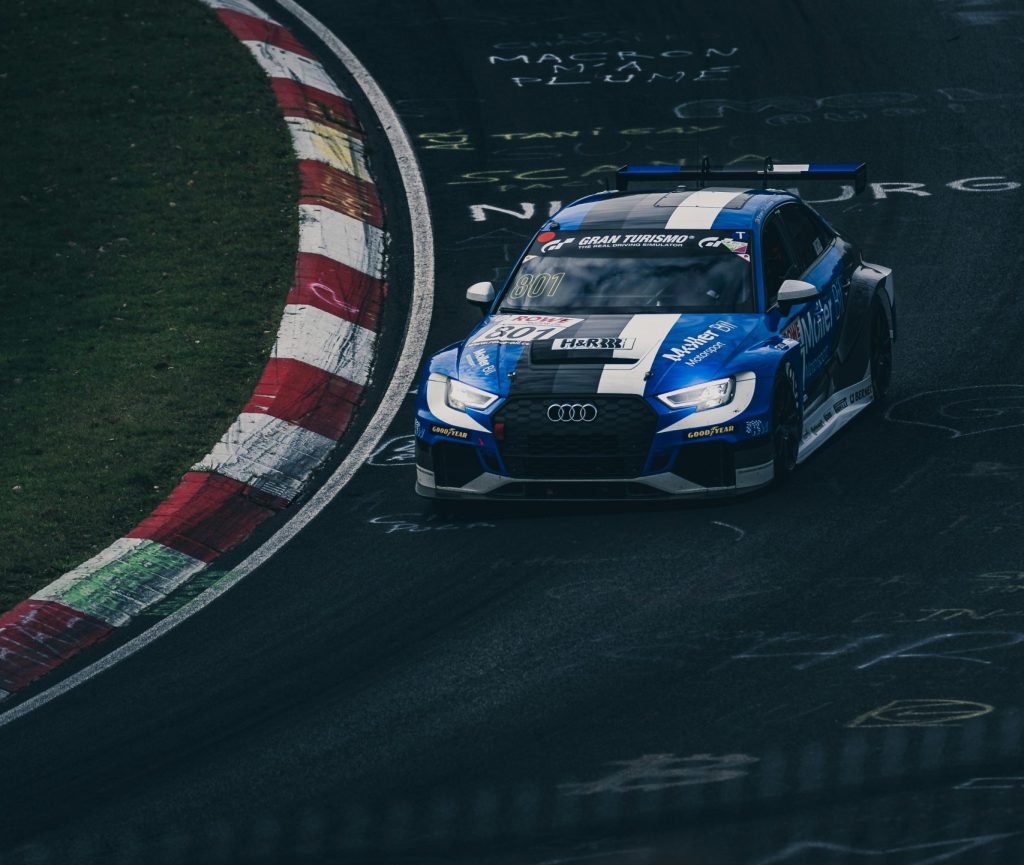
The Future Outlook: What Comes Next?
2026 Redesign: Embracing Electrification
As we look toward the future, the RS7 is set to evolve with the changing automotive landscape. Rumors and early information about the 2026 redesign suggest a significant shift toward electrification:
- Powertrain: A 725hp plug-in hybrid combining a 2.9L TFSI V6 with a 150kW electric motor
- Battery: A substantial 17.9kWh pack providing approximately 35 miles of pure electric range
- Formula 1 Technology: MGU-H derived turbo compounding and brake-by-wire systems adapted from motorsport
This shift reflects the broader industry trend toward electrification while maintaining the performance expected from an RS model. The incorporation of F1-derived technology is particularly intriguing, suggesting that Audi is committed to preserving the RS7’s performance credentials even as it embraces a more sustainable future.
Autonomous Tech: The Self-Driving Grand Tourer
The future Audi RS7 is also expected to feature advanced autonomous capabilities:
- Level 3 Capability: Traffic Jam Pilot functioning at speeds up to 37mph
- V2X Communication: Real-time hazard alerts through car-to-infrastructure communication
These features represent a logical evolution for a grand touring vehicle designed for both spirited driving and comfortable long-distance travel.
Hidden Gems: Details That Enthusiasts Appreciate
The Devil’s in the Details
What truly separates the Audi RS7 from lesser vehicles are the thoughtful engineering touches that often go unnoticed:
- Acoustic Engineering: Deliberate engine bay insulation deletion to enhance the “raw” V8 soundtrack
- Thermal Management: Seven separate coolant circuits with 3D-printed headers for optimal temperature control
- Aerodynamic Tricks: Underbody vortex generators reducing the drag coefficient to an impressive 0.34
These details might not make headlines, but they contribute significantly to the overall driving experience and performance envelope of the Audi RS7.
Ownership Modifications: Making It Your Own
For those looking to personalize their Audi RS7, the aftermarket offers numerous options:
- Wheels: 22″ HRE P101SC forged monoblock wheels (weighing just 28 pounds each) provide both aesthetic enhancement and reduced unsprung weight
- Exhaust: An Akrapovič titanium system saves 22 pounds while delivering a more aggressive soundtrack
- Software: ABT Power S packages can boost output to 700 horsepower while maintaining warranty coverage
Conclusion: The Thinking Enthusiast’s Choice
Audi’s engineers have described the Audi RS7 as “a precision scalpel rather than a sledgehammer” – an apt metaphor for its approach to performance. In an automotive landscape increasingly dominated by brazen styling and attention-seeking exhausts, the RS7 stands apart as a more thoughtful proposition.
What makes the Audi RS7 special isn’t just its impressive performance metrics or luxury credentials – though it certainly excels in both areas. Rather, it’s the seamless integration of seemingly contradictory attributes: ferocious acceleration with refined comfort, cutting-edge technology with driver engagement, and supercar performance with everyday practicality.
As we approach what may be the twilight of the pure internal combustion era, the current Audi RS7 represents a high-water mark for the grand touring sedan. It embodies automotive passion in its purest form – a masterful blend of engineering excellence and emotional appeal that rewards both the driver and passengers alike.
For those who appreciate the subtle art of going very fast without making a scene, who value capability without compromising comfort, and who understand that true luxury includes performance as well as premium materials, the Audi RS7 remains the benchmark against which all other performance sedans must be measured.
Want to explore more about high-performance luxury vehicles? Visit Car and Driver’s comprehensive review of the Audi RS7.
